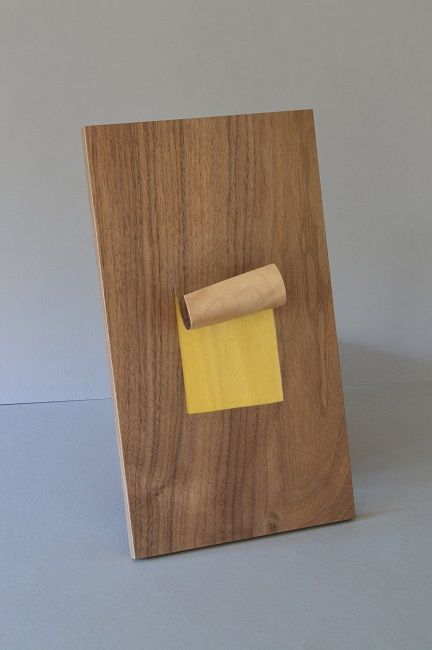Hugh Cummins
'Study in White and Yellow'
A closer look by Sarah Dapoigny, intern at Olivier Cornet Gallery
Following the showcasing of Hugh Cummins's work and practice at the Olivier Cornet Gallery during Heritage Week 2023, I decided to take a closer look at one of his works available in the gallery's storage area, which intrigued me since I began my internship: Study in White & Yellow. I will start with a brief introduction to the work before describing it. Then, I will conclude this study with my interpretation and vision of Study in White & Yellow.
First of all, this abstract sculpture measures 32x18cm and is a high relief in walnut, maple & sycamore dyed yellow. It was created by Hugh Cummins, a contemporary Irish artist represented by the Olivier Cornet gallery. Hugh Cummins is an artist with a design background who works with wood.
To describe it more precisely, Study in White & Yellow is a rectangular piece of plywood created using marquetry. In fact, marquetry is a technique involving the use and assembly of wood veneers. At its centre, we can see part of the veneer that has been cut away, detached and curled up on itself, revealing the lower layer of yellow wood. There's an impression of movement, as if the wood is coming apart.
Study in White & Yellow reflects the work of Hugh Cummins: "My aim is to illustrate lightness and movement".
Indeed, we can see that the work demonstrates delicate, light marquetry using precious wood. Study in White & Yellow also shows lightness in the movement suggested by the wood.
Finally, Study in White & Yellow is a truly astonishing work in my opinion, creating an unexpected, almost humorous rupture. In fact, it reminds me of several things: whether it's the cartoon-like scene of a guitar or violin string that snaps, or even a little bit of skin that you might have around your fingernails. A sort of raw wound that the apparent yellow under the layer of brown wood can evoke.
Study in White & Yellow also reminds me of a well-known work by Gustave Caillebotte: 'The Floor Scrapers', which shows wood shavings in the same curled-up shape. These shavings come from the top layer of the boards.
Whether for wood or skin, the raw wound is found in the phenomenon of desquamation:
"In dermatology, desquamation refers to the loss of the superficial layers of the epidermis; esquamation or peeling of the bark is a normal process, particularly in spring, when the tree begins to grow. The outer layers of the bark are dead tissue and therefore cannot grow."
The bark is, in a sense, the 'skin of the tree'.
The bark is, in a sense, the 'skin of the tree'.
Sarah Dapoigny
[Note from the gallerist: This work was part of a series first presented in our group show Somewhere between perception and reality at VUE Art Fair, RHA, November 2018, then as part of our Winter group show here at the gallery. This particular work was shown as part of our group exhibition 'Memento, looking back, Looking forward'.]

